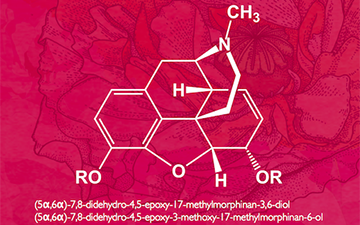Morphine (INN)/ˈmɔrfiːn/), sold under many trade names, is a pain medication of the opiate type. It acts directly on the central nervous system (CNS) to decrease the feeling of pain. It can be used for bothacute pain and chronic pain. Morphine is also frequently used for pain from myocardial infarctionand during labour. It can be given by mouth, into a muscle, under the skin, intravenously, into the space around the spinal cord, or rectally.[3] Maximum effect is around 20 min when given intravenously and 60 min when given by mouth while duration of effect is between three and seven hours.[3][4] Long acting formulations also exist.[3]
Potentially serious side effects include a decreased respiratory effort and low blood pressure. Morphine has a high potential for addiction and abuse. If the dose is reduced after long term use withdrawal may occur. Common side effects include drowsiness, vomiting, and constipation. Caution is advised when used during pregnancy or breast feeding as morphine will affect the infant.[3]
Morphine was first isolated between 1803 and 1805 by Friedrich Sertürner.[5] This is generally believed to be the first isolation of an active ingredient from a plant.[6] Merck began marketing it commercially in 1827.[5] Morphine was more widely used after the invention of the hypodermic syringe in 1853–1855.[5][7] Sertürner originally named the substancemorphium after the Greek god of dreams, Morpheus, for its tendency to cause sleep.[7][8]
The primary source of morphine is isolation frompoppy straw of the opium poppy.[9] In 2013 an estimated 523,000 kilograms of morphine were produced.[10] About 45,000 kilograms were used directly for pain, an increase over the last twenty years of four times.[10] Most use for this purpose was in the developed world.[10] About 70% of morphine is used to make other opioids such as hydromorphone,oxycodone, heroin, and methadone.[10][11][12] It is a Schedule II drug in the United States,[11] Class A in the United Kingdom,[13] and Schedule I inCanada.[14] It is on the WHO Model List of Essential Medicines, the most important medications needed in a basic health system.[15]
– – –
Codeine or 3-methylmorphine (a naturally occurring methylated morphine) is an opiate used to treat pain, as a cough medicine, and for diarrhea. It is often sold as a salt in the form of either codeine sulfate or codeine phosphate in the United States and Australia; codeine hydrochloride is more common worldwide and the citrate, hydroiodide, hydrobromide, tartrate, and other salts are also seen.[2]
Codeine is the second-most predominant alkaloid inopium, at up to three percent. Although codeine can be extracted from natural sources, a semi-syntheticprocess is the primary source of codeine for pharmaceutical use. It is considered the prototype of the weak to midrange opioids (tramadol,dextropropoxyphene, dihydrocodeine, hydrocodone,oxycodone).
In 2013 about 361,000 kilograms of codeine were produced while 249,000 kilograms were used.[3] It is the most commonly taken opiate.[3] It is on the WHO Model List of Essential Medicines, a list of the most important medication needed in a basic health system.[4]
.(From Wikipedia, July 2015)


